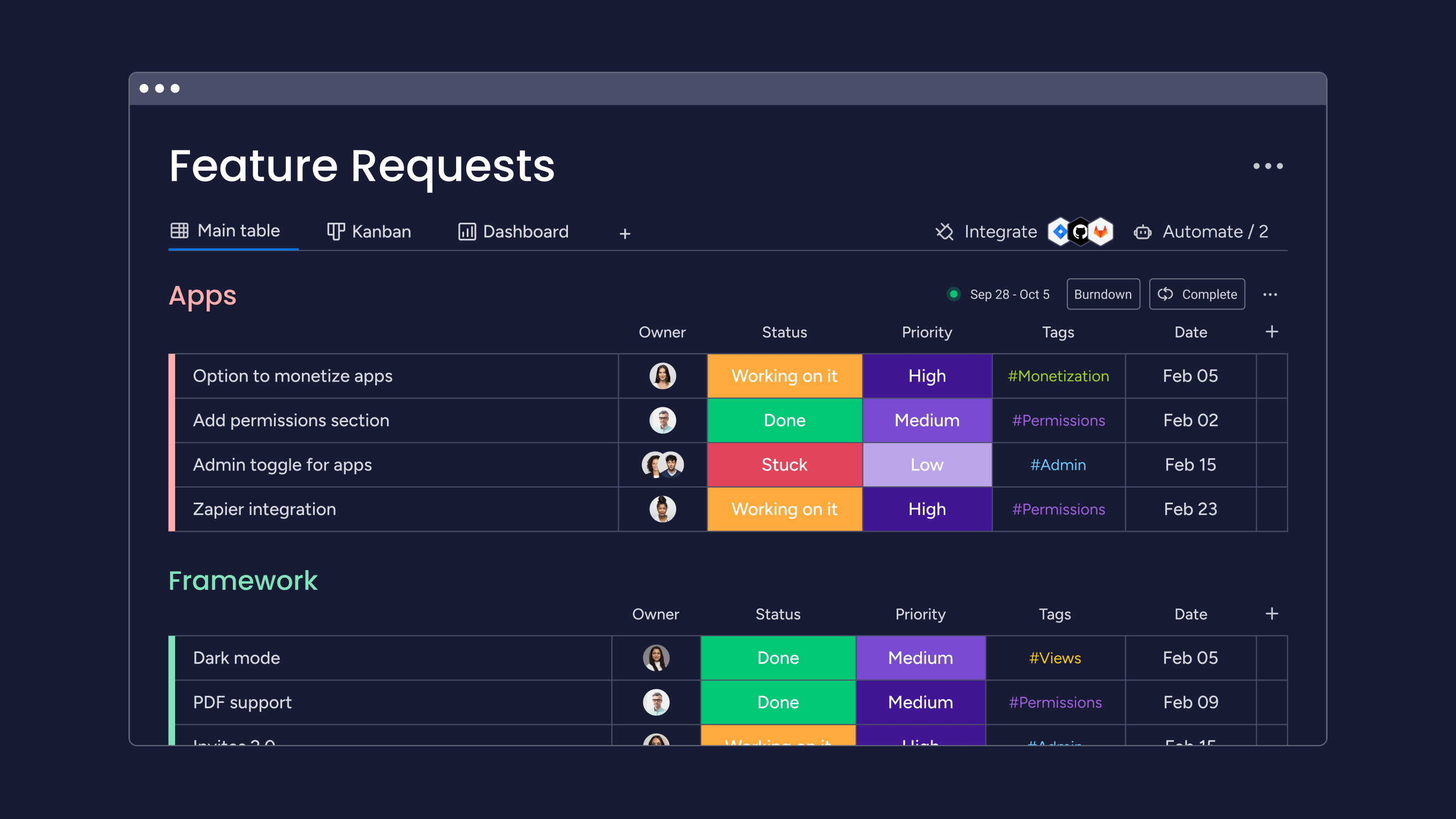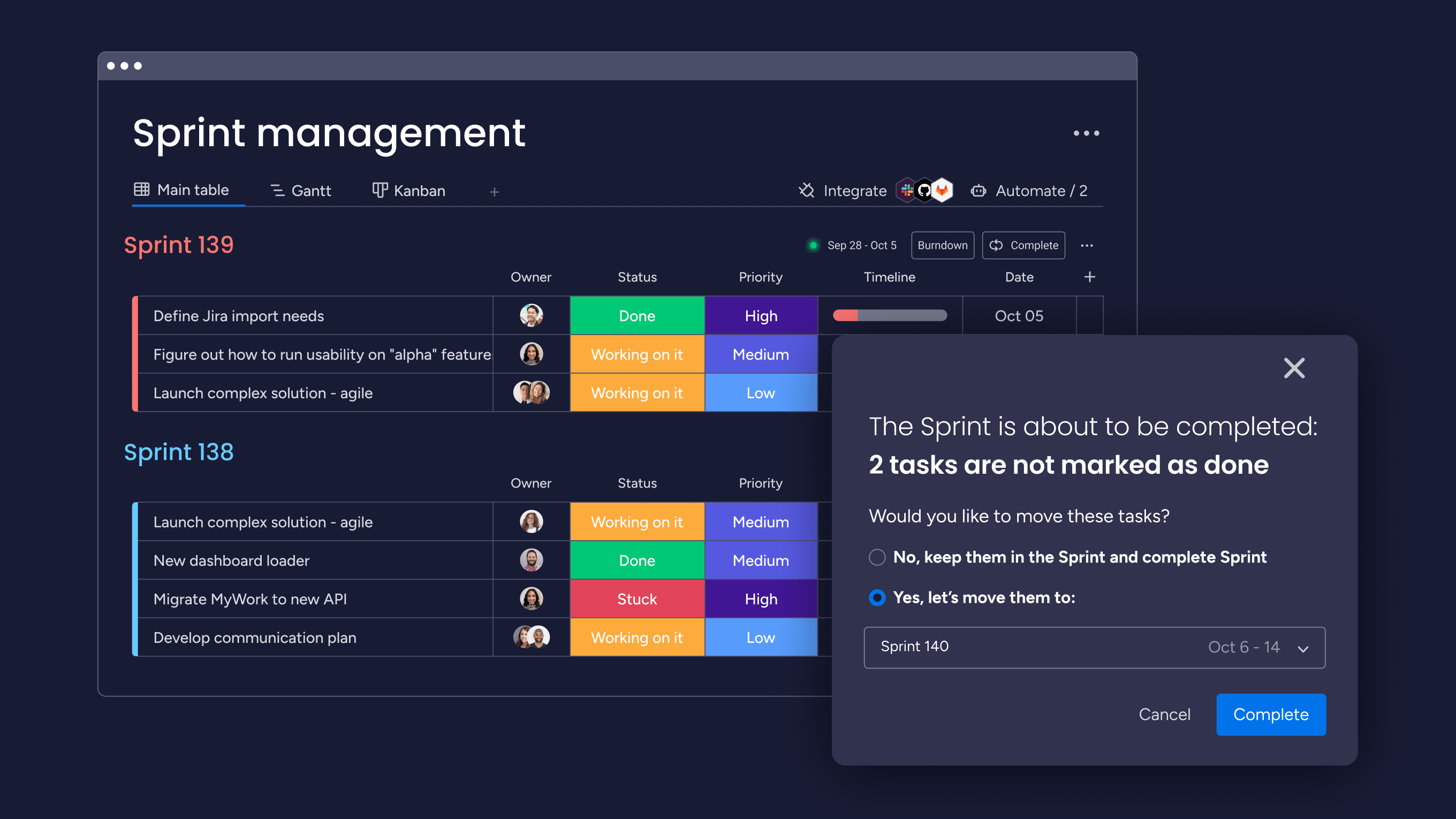From the invention of the wheel to artificial intelligence, from the printing press to the internet, innovation changes the world. Product innovation is the key to business success. It’s what catches and keeps the attention of potential customers. And it’s an ongoing process. To keep up with the competition, you can’t afford to be complacent.
Here, we’ll look at what we mean by product innovation, why it’s important, and give you four innovation tips to help you stay ahead of the curve. We’ll also show you how monday dev can help your product team focus on innovation and spend less time on busy work.
Try monday devWhat is product innovation?
Product innovation is the process of finding novel solutions to address the problems and needs of your potential customers — often even before they know they want or need those solutions.
Product innovation is what adds the magic to product development. The most successful products and services are those that not only meet but surpass consumer expectations.
Whether it’s an entirely new and groundbreaking product (like the first iPhone), or an inventive upgrade to an existing one (like adding Siri’s AI-powered assistant to the iPhone), product innovation is all about making your product more attractive to your customers.

Types of product innovation
There’s a good reason that we think of “reinventing the wheel” as the epitome of wasted, redundant effort. The wheel was such a fundamental innovation that it has stood the test of time like nothing else. And yet, a forged, magnesium alloy car wheel is a far cry from an ancient Mesopotamian potter’s wheel.
While the general principle of the wheel hasn’t changed for thousands of years, it has been tweaked, improved, and applied to a million new contexts. This demonstrates two distinct, yet complementary, approaches to product innovation — radical innovation and incremental innovation.
Radical vs incremental product innovation
Radical innovation results in an entirely new product or service that is transformative and disruptive to existing markets, or even creates new markets. The smartphone is a great example, changing not only how we communicate, but also how we work, learn, and even play.
Incremental innovation, on the other hand, makes smaller changes and improvements to existing products or services. Think of how the iPhone has gone through dozens of iterations, year after year, to enhance the features, performance, or user experience — while remaining recognizably the iPhone.
Radical and incremental product innovation can also be viewed in other ways, including architectural, modular, and discontinuous innovation.
Modular vs architectural innovation
Modular innovation involves creating or changing the core components of a product so that the product itself operates in a new or improved way. In this way, modular innovation is effectively radical at a cellular level.
For example, monday.com comprises several distinct innovative products or modules — namely, monday work management, monday sales CRM, and monday dev — that sit within the overarching monday.com architectural framework.
Architectural innovation, meanwhile, affects that underlying architecture. It reconfigures and enhances how the core components interact with each other, but without changing or replacing those components.
For example, the architecture of monday.com’s database, mondayDB, improves how boards load, keeping loading time constant even for larger and more complex boards.
Discontinuous innovation
Discontinuous innovation resembles radical innovation in that it involves a fundamental departure from existing products, services, or technologies. However, what makes a discontinuous innovation distinct is the scale of its impact. This is a truly disruptive innovation that can render existing solutions obsolete — effectively a revolutionary paradigm shift that creates new markets, industries, or behaviors.
When Netflix started online DVD rental by mail, it was a radical innovation. It created a new market and new consumer behaviors that competed with physical video stores like Blockbuster. But when it pioneered on-demand video streaming, it created an entirely new way of watching TV and movies, while sounding the death knell of those physical stores.
Why is product innovation important?
If you work in product development, you’ll know that innovation is the key to keeping ahead of your competition. Here are just a few of the reasons why product innovation is vital for business success:
Product innovation drives quality
The main point of innovation is to deliver quality products and services to your customers. Whether you’re launching a brand new product into the market, or improving the quality or efficiency of your existing offerings, the aim is that potential customers will feel that the innovation will make their lives better or easier in some way.
For example, monday.com has recently added features that enable developers to use generative AI to develop innovative, customized apps that can improve workflow efficiency. These can be used to automate tasks, create project plans, write and edit emails, and summarize complex topics, ensuring that teams can work and collaborate more efficiently.
Try monday devInnovation keeps your customers engaged
However happy you are with your new Tesla, it will eventually lose that “new car smell”. We consumers can be fickle creatures, always looking out for the next big thing. If you can’t keep your customers interested, you’ll eventually lose them to the competition that’s offering something shinier and newer.
This is where product innovation comes in. Innovative companies are always looking for new ideas to revitalize their customers’ interests and address their changing needs. If you can do this successfully, with breakthroughs and upgrades that meet expectations, you’ll build customer satisfaction, and even more importantly, brand loyalty.
Product innovation helps you stand out
Innovation is all about doing things differently, in ways that make people take notice. When you innovate, you differentiate your products from those of your competitors and demonstrate your unique selling proposition (USP). This can give you a competitive advantage — even encouraging customers to switch brands.
For instance, by moving video conferencing to the cloud to support large organizations, Zoom was able to differentiate itself from Skype.
Product innovation drives profits
Innovation is, by its nature, risky. And it’s costly, both in terms of time and money. If your product doesn’t take off, it could damage your reputation as well as your bottom line.
Business leaders understand this and know that it’s an eternal challenge. According to McKinsey, 84% of CEOs think that innovation is essential for business growth. Yet just 6% are happy with their innovation efforts.
But when it’s successful, the risk is more than worth it. Those businesses that do master innovation generate 2.4 times the profit of other companies.
How to innovate: 4 best practice tips

Product innovation begins with an idea, sparked by a need or a gap in the market. You then hone and refine your idea, through research, planning, design, and testing. And when it’s ready, you make it accessible to your consumers. Here are our top tips for best practices in product innovation:
1. Know your customers
Conduct market research to analyze the needs and interests of your customers. Make sure you know exactly what they want, need, and will use. Make sure you understand the trends and the gaps in the market. Familiarize yourself with existing or upcoming innovations so you can carve your unique niche.
monday dev can make it easier to capture customer demands. Our feature requests board lets you track customer stories, assign priorities and deadlines, and add tags to group requests into categories.
Try monday dev2. Generate ideas collaboratively
Bring together ideas and perspectives from a diverse range of cross-functional innovators and partners. Encourage creative and innovative thinking and experimentation. Remember that every bright idea is not necessarily the right idea for innovation. As Steve Jobs put it:
“Innovation is not about saying yes to everything. It’s about saying no to all but the most crucial features.”
3. Develop your product strategy
Have a clear action plan for the entire product lifecycle. Set out your vision, goals, and key initiatives for how you will develop and market the product, and how it fits in with your overall business strategy. Consider costs and how the product will be differentiated from the competition. This way, you can be sure that your product will address your customers’ needs and support your company’s success.
4. Develop and test your product
Thoroughly test and tweak the design of your prototype to ensure that you can perfect your final product. Make sure your product focuses on features that are the most viable and desirable. Before launching your product innovation, test the functionality in real-world settings to make sure it’s as good as your customers want it to be.
How monday dev can support product innovation

monday.com has always approached project and work management with innovation in mind. Not only is monday.com innovative, but it also supports companies in managing their own product innovation.
monday dev, built on top of monday.com Work OS, was created to equip product and development teams with the tools to seamlessly plan, build and launch new products in a single platform.
With monday dev, your teams can tailor product innovation processes and develop your unique product strategy. Here’s how:
- Open access to generative AI capabilities and a low-code/no-code infrastructure allows developers to innovate and create original and cutting-edge software solutions for all kinds of use cases.
- Product Roadmaps keep your teams and workflows on track and focused, so they can plan, prioritize, map, and share your product vision and direction.
- Q Goals let you monitor your quarterly objectives, linked directly from the Product Roadmap board.
- Sprint management lets you keep your continuous innovation improvements moving
- Feature Requests let users get actively involved in the product innovation process, submitting features they want to see
- Over 200 integrated tools like Slack or GitHub make it easier to automate tasks, send notifications, and streamline workflows.
Mastering product innovation, whether radical or incremental, will help you offer leading-edge products and services, keeping your customers and your business satisfied.
Find out why monday dev is the best solution to help your team manage your product innovation.
 Get started
Get started 
